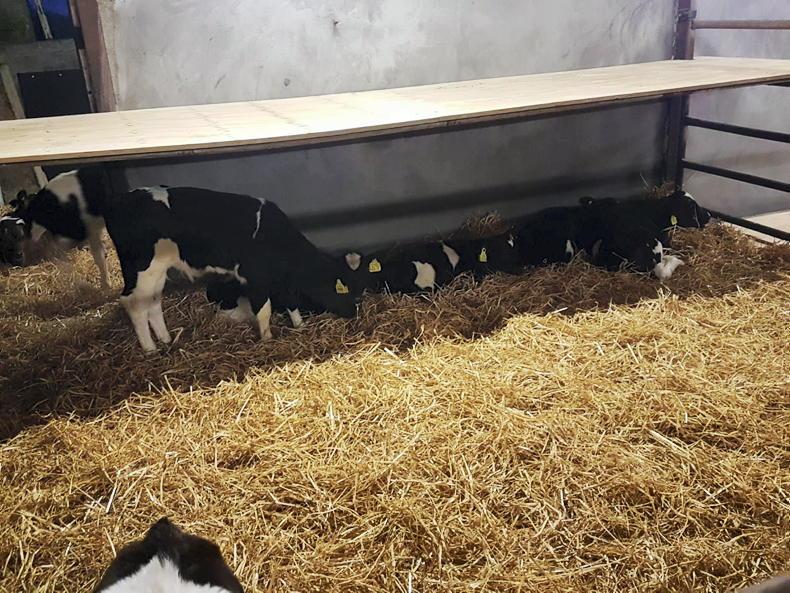The majority of calves that are reared on farms this spring will be done in sheds that have not been specifically designed with calf rearing in mind.
This, along with the vast array of weather conditions experienced throughout the rearing phase, mean that no shed is completely suited to calf rearing.
Microclimates are becoming increasingly popular in calf sheds. This involves creating a canopy over the calves’ heads, typically at the back of pens to eliminate drafts and keep the temperature of the lying area more consistent. Construction can be as simple as a few sheets of 8×4 plywood.
Microclimates should not be too deep, as this can affect the success of the ventilation. What we do not want to do is stop the flow of air in the shed and stop stale air from being removed from the calves’ environment.

This canopy was created using 8 by 4 sheets of plywood secured using two steal pipes running the length of the pen.
Any farmer who has one installed in the shed will tell you that, without fail, calves will constantly choose to lie in under the microclimate.
This has been particularly true in the recent windy wet weather, where some pens may have been breezy or wet had the microclimate not been in place.
Maximising growth
If you think of the total amount of feed (milk, fibre source and concentrate) that is fed to a calf each day as a full pint glass.
When the calf consumes this feed, the first proportion of the pint glass goes to the animal's maintenance needs. That is, energy required for the animal to keep its temperature constant throughout the day, energy required for the animal to get up and move around and the energy required to keep the body functioning.
Once that is taken care of, the remainder of the glass of feed can be targeted to growth and development. This is where we want to divert as much of that glass of feed to each day.
However, if the calf environment is poor, for example if there are draughts at animal level or where the bedding is insufficient or wet, then more of our glass of feed is going to be diverted away from growth and into maintaining the calf’s core temperature.
This will lead to lower daily liveweight gains and, in severe cases, to calf sickness.
Bedding
The bedding in the calf shed needs to be deep and dry at all times to ensure they are not burning energy maintaining their core temperature. The best way to check this is to kneel down in the pen. If you have wet knees when you stand up, the bedding is insufficient.
The microclimate can help to keep rainfall off the bedding where it is coming in through spaced sheeting or open-sided sheds. It will also help keep the temperature of the lying environment more consistent.
The majority of calves that are reared on farms this spring will be done in sheds that have not been specifically designed with calf rearing in mind.
This, along with the vast array of weather conditions experienced throughout the rearing phase, mean that no shed is completely suited to calf rearing.
Microclimates are becoming increasingly popular in calf sheds. This involves creating a canopy over the calves’ heads, typically at the back of pens to eliminate drafts and keep the temperature of the lying area more consistent. Construction can be as simple as a few sheets of 8×4 plywood.
Microclimates should not be too deep, as this can affect the success of the ventilation. What we do not want to do is stop the flow of air in the shed and stop stale air from being removed from the calves’ environment.

This canopy was created using 8 by 4 sheets of plywood secured using two steal pipes running the length of the pen.
Any farmer who has one installed in the shed will tell you that, without fail, calves will constantly choose to lie in under the microclimate.
This has been particularly true in the recent windy wet weather, where some pens may have been breezy or wet had the microclimate not been in place.
Maximising growth
If you think of the total amount of feed (milk, fibre source and concentrate) that is fed to a calf each day as a full pint glass.
When the calf consumes this feed, the first proportion of the pint glass goes to the animal's maintenance needs. That is, energy required for the animal to keep its temperature constant throughout the day, energy required for the animal to get up and move around and the energy required to keep the body functioning.
Once that is taken care of, the remainder of the glass of feed can be targeted to growth and development. This is where we want to divert as much of that glass of feed to each day.
However, if the calf environment is poor, for example if there are draughts at animal level or where the bedding is insufficient or wet, then more of our glass of feed is going to be diverted away from growth and into maintaining the calf’s core temperature.
This will lead to lower daily liveweight gains and, in severe cases, to calf sickness.
Bedding
The bedding in the calf shed needs to be deep and dry at all times to ensure they are not burning energy maintaining their core temperature. The best way to check this is to kneel down in the pen. If you have wet knees when you stand up, the bedding is insufficient.
The microclimate can help to keep rainfall off the bedding where it is coming in through spaced sheeting or open-sided sheds. It will also help keep the temperature of the lying environment more consistent.







 This is a subscriber-only article
This is a subscriber-only article










SHARING OPTIONS: